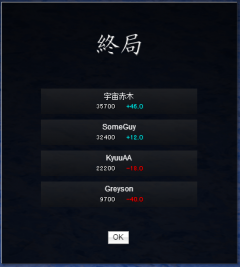Oka and uma
At the end of the game, the raw scores are converted into an "end game score". This is most commonly referred as the plus-minus (+/-) score. The four end game scores are set up to equal to zero. However, due to rounding errors, it is possible for the scores to equal to 1 or -1. In this case, the leader's end game score is adjusted to ensure a zero sum.
Oka and uma
The oka is the point difference between the start score and the target score; and then it is multiplied by the number of players. In general, this can be viewed as the "ante". Typically, the start score and target score are 25,000 pts and 30,000 pts respectively. So, in this case the oka is 5,000 x 4.
The uma is the set point spread applied to the players at the end of the game. The typical point spread uses (+20/+10/-10/-20), applied to the players in rank order.
Procedure
The end game score is calculated as follows:
- Raw are taken at the end of the game, naturally ordered by the final point values.
- Note the start score and target score point difference, find the oka.
- Subtract the target score from the final point values.
- Add the oka to the winner.
- Divide by 1,000.
- Round to the nearest integer. If the division result produces a digit of 0.5, then the number is rounded down.
- Apply the uma spread, if any.
- If the sum of all four does not equal to zero, then the winner's score is adjusted to produce a zero sum.
Due to rounding, the final values may not add up to zero. Therefore, it may become necessary to alter the winner's score. Usually, the difference is only +/- 1.
Shortcut

This short cut only applies to the distribution of (+20/+10/-10/-20). Using the procedure above, suppose all players unrealistically finish with 25,000 points each. The target points is 30,000 as standard.
| End points | End pts rounded & Div by 1000 |
Oka | Minus target | Add oka | Div 1000 | Rounded | +/- | End score | Diff. from 2nd column |
|---|---|---|---|---|---|---|---|---|---|
| 25000 | 25 | 20000 | -5000 | 15000 | 15 | 15 | +20 | 35 | +10 |
| 25000 | 25 | 0 | -5000 | -5000 | -5 | -5 | +10 | 5 | -20 |
| 25000 | 25 | 0 | -5000 | -5000 | -5 | -5 | -10 | -15 | -40 |
| 25000 | 25 | 0 | -5000 | -5000 | -5 | -5 | -20 | -25 | -50 |
As a shortcut, the adjustment can use the scores in the first column. Then the scores can be divided by 1000 and rounded. Finally, the values in the last column can be used to adjust for the final scores. Once again, this only works with the regular (+20/+10/-10/-20) uma.
Just to show, the values in the image to the right are used:
| End points | End pts rounded & Div by 1000 |
Oka | Minus target | Add oka | Div 1000 | Rounded | +/- | End score | Diff. from 2nd column |
|---|---|---|---|---|---|---|---|---|---|
| 35700 | 36 | 20000 | 5700 | 25700 | 25.7 | 26 | +20 | +46 | +10 |
| 32400 | 32 | 0 | 2400 | 2400 | 2.4 | 2 | +10 | +12 | -20 |
| 22200 | 22 | 0 | -7800 | -7800 | -7.8 | -8 | -10 | -18 | -40 |
| 9700 | 10 | 0 | -20300 | -20300 | -20.3 | -20 | -20 | -40 | -50 |
If the original scores of (35700, 32400, 22200, 9700) were rounded and divided by 1000, the original scores would be converted to (36, 32, 22, 10). If (+10, -20, -40, -50) were added to the converted numbers, they would produce (46, 12, -18, -40).